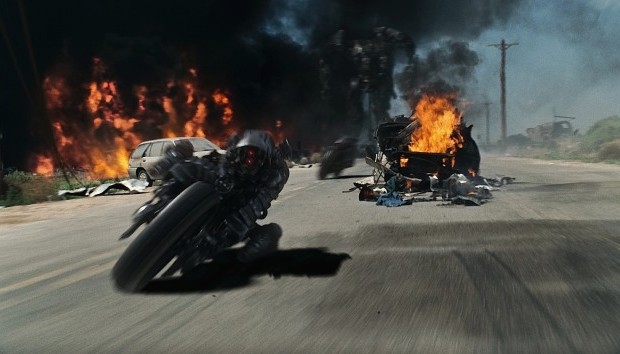
Terminator Salvation is a fireworks show that pops the eyes and blasts the ears, and for awhile, it has the potential to be more than that. But it has abandoned everything visionary that made the James Cameron installments classics in the sci-fi genre. The new film has countless fights in the desert. Bands of Resistance fighters combat one or two cyborg killing machines at a time, or perhaps a lethal hovercraft. In the series origins there was apocalyptic hopelessness shot in black and dark blues colors. Armies of Resistance fighters were matchless against innumerable cyborg armies. Survivors, the sick and feeble, crowded helplessly in the underground. Too bleak to laugh, to love, to bundle safely. This new film by the director who calls himself McG (“Charlie’s Angels”) prefers predictable action-adventure conventions and depends on developing an overly sophisticated Resistance that doesn’t fit the series lore.
If there’s a casting concept that makes sense it is hiring Christian Bale to play post-apocalyptic John Connor circa 2018. Bale is the best actor to play John Connor since that anonymous actor played the older John Connor for a few seconds in the prelude of “Terminator 2: Judgment Day” (1991). Bale has a brooding presence in roles good (“The Dark Knight”) or evil (“American Psycho”), and that fuming ticking time-bomb persona in him is perfect for a character like John Connor, who is one of the last Resistance aspiring to save humankind. Connor is a character imbued with shame and fury, as if he hasn’t gone far enough to risk his life for the sake of a greater purpose. Yet forget the character for a second. What makes Bale, a performer with great tension wound up in his face, so interesting is this unusual paradox: He simultaneously craves to be in the center frame and also appears to be the only actor out there today that seems like he hates himself for not putting enough of himself on the line. Sort of like John Connor.
Lesser known Sam Worthington is also a casting coup. He plays Marcus Wright, whom in 2003 is a death row convict shortly away from execution. Then Judgment Day came which annihilated most of the human race and pitted surviving humans in a war against the machines. Marcus awakens in the future to a devastated mankind. Worthington is given piss-poor dialogue to work with considering how he never asks the right questions as to why the world came out this way. Worthington does have an affecting scene where he asks Resistance fighter Blair Williams (Moon Bloodgood) if she believes people deserve a second chance. Worthington is an unknown stranger who will eventually – and conveniently – meet up with John Connor as well as contribute to the fate of mankind.
The apocalyptic future is a man’s world but what about the women? Bloodgood is the most stirring female character in the film, certainly more suited to the story’s tone than actress Bryce Dallas Howard (“Lady in the Water”), whom as John Connor’s wife, seems appropriately concerned with John’s safety but not too reactive when it comes to being concerned about the well-being of the entire human species. Here is an actress with the myopic limitation to concern herself on how to play an individual scene but not fully realizing of the tone and atmosphere of the movie’s whole implications.
Getting back to the essentials, the key character to the film, and nearly the entire series, is Kyle Reese who is in this film played by Anton Yelchin (“Charlie Bartlett”) who plays Reese as a young man. Reese will eventually grow up and travel back in time to 1984, behest, he was played by Michael Biehn in “The Terminator.” Reese would eventually impregnate Sarah Connor and give birth to John. It is retrospective memory of Michael Biehn’s performance that made early “Terminator” movies so touching. I have mentioned the gloom and doom, the hopelessness, the lovelessness, of Cameron’s first film. Why was his dark imagination so much more appealing and engaging?
What made the emotional content so rich is that Biehn came from a future of war-torn madness, where his character Reese had rarely experienced human basic wants such as honest love and tenderness, and hungered for it with Sarah Connor. But on a greater analytical scale, the few human optimists fighting through the darkness and debasement is much more compelling than seeing this version’s future where everybody seems instilled with strong coping mechanisms and gung-ho spirits.
“Terminator Salvation,” which seems more concerned with its pyrotechnics, loses its sense of sci-fi ingredients of paranoia and dystopia, the bread and butter of true science-fiction. In one scene, an outfit compound behaves mutinously over the arrival of human visitors Marcus Wright and Kyle Reese and youngling Star (Jadagrace). Den mother Virginia (Jane Alexander) of the compound, insisting an exchange of peace, offers carrots and cabbage to the youngster. All I could wonder is how in the world could there be a surplus of vegetables in the desert where no agriculture exists? In one scene, there are a couple of roaming goats in the background. That makes more sense. People could live on goat meat.
 Every new “Terminator” movie seems to introduce a new cyborg model. While the movie employs the standard all-metalic model T-600 frequently, this installment nevertheless does introduce the Harvester, a big hovercraft which snatches people up with its claws and transports them back to Skynet where cyborgs generate themselves. This concept of collecting people has been seen in “Soylent Green” and “War of the Worlds,” in both movies the harvesting of people had practical purpose. But the Harvester in this film raises dubious issues. People are collected. Sent up north to Skynet. Put through an assembly line (a slaughterhouse? No, not quite). Then encaged. There is no point of collecting and keeping people alive except to lure Resistance rescue teams. If that’s the case, why don’t the Terminators kill 98% of their captives and keep the ones they need for their insurance purposes? Why risk a force of 100% rebellion? Aren’t these cyborgs supposed to be merciless and uncompromising efficiency experts?
Every new “Terminator” movie seems to introduce a new cyborg model. While the movie employs the standard all-metalic model T-600 frequently, this installment nevertheless does introduce the Harvester, a big hovercraft which snatches people up with its claws and transports them back to Skynet where cyborgs generate themselves. This concept of collecting people has been seen in “Soylent Green” and “War of the Worlds,” in both movies the harvesting of people had practical purpose. But the Harvester in this film raises dubious issues. People are collected. Sent up north to Skynet. Put through an assembly line (a slaughterhouse? No, not quite). Then encaged. There is no point of collecting and keeping people alive except to lure Resistance rescue teams. If that’s the case, why don’t the Terminators kill 98% of their captives and keep the ones they need for their insurance purposes? Why risk a force of 100% rebellion? Aren’t these cyborgs supposed to be merciless and uncompromising efficiency experts?
In a movie filled with overblown action, there is a five-minute segment about halfway in where the Resistance team blows up the surrounding perimeter of their compound area, setting tons of trees on fire in the process. Every time they fight they are signaling other Terminators to locate their area. It’s foolish to believe that a sensible John Connor, and his militia, would shoot after two targets whom are a limited threat in relation to the firestorm of Terminators that could now locate and infiltrate their compound.
“Terminator Salvation” really isn’t much different from other action movies today which contain scenes of heroes getting pummeled before they pop back up again to fight some more. It’s the multi-life video game syndrome. I suppose to demerit this film on the same grounds of other contemporary action movies that violate the same sin is unfair, except that the “Terminator” movies deserve much better. When James Cameron unleashed the original part one (and part two with its ground-breaking special effects) he made humans not invincible or impervious to pain, but vulnerable and pitiable. This made for two films that were scarier, more terrifying, and a lot more thrilling. “Salvation” does have a surprise or two but it’s the story foundation that crumbles disappointingly. As the story removes its action-adventure from the city to the desert (a cheap and plain way to shoot a movie), it is all the more double-disappointing.
115 Minutes. Rated PG-13.
SCI-FI & FANTASY / ACTION FANS / BLOCKBUSTER WEEKEND CROWDS
Film Cousins: “The Terminator” (1984); “Cyborg” (1989); “Terminator 2: Judgment Day” (1991); “Terminator 3: Rise of the Machines” (2003).







